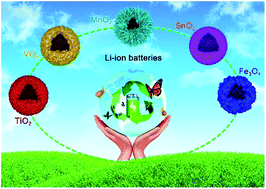当前位置:
X-MOL 学术
›
J. Mater. Chem. A
›
论文详情
Our official English website, www.x-mol.net, welcomes your feedback! (Note: you will need to create a separate account there.)
Template-free synthesis of metal oxide hollow micro-/nanospheres via Ostwald ripening for lithium-ion batteries
Journal of Materials Chemistry A ( IF 11.9 ) Pub Date : 2018-05-01 00:00:00 , DOI: 10.1039/c8ta03161d Wangsuo Weng 1, 2, 3, 4, 5 , Jun Lin 1, 2, 3, 4, 5 , Yichen Du 1, 2, 3, 4, 5 , Xufang Ge 1, 2, 3, 4, 5 , Xiaosi Zhou 1, 2, 3, 4, 5 , Jianchun Bao 1, 2, 3, 4, 5
Journal of Materials Chemistry A ( IF 11.9 ) Pub Date : 2018-05-01 00:00:00 , DOI: 10.1039/c8ta03161d Wangsuo Weng 1, 2, 3, 4, 5 , Jun Lin 1, 2, 3, 4, 5 , Yichen Du 1, 2, 3, 4, 5 , Xufang Ge 1, 2, 3, 4, 5 , Xiaosi Zhou 1, 2, 3, 4, 5 , Jianchun Bao 1, 2, 3, 4, 5
Affiliation

|
Transition metal oxide hollow structures have drawn tremendous attention as electrode materials for lithium-ion batteries (LIBs) due to their unique structural features and rich chemical properties. As electrode materials for LIBs, transition metal oxide hollow structures exhibit high specific capacity, excellent rate capability, and outstanding cycling performance. In the past few decades, unremitting efforts have been devoted to the design and synthesis of various transition metal oxide hollow structures with controlled shape, composition, and structural complexity to boost their electrochemical properties. Direct synthesis without the need for additional templates is preferred in practical applications due to significantly reduced production cost and the ease of scaling up. A number of template-free approaches have been developed for fabricating hollow structures on the basis of different mechanisms, including the Kirkendall effect, oriented attachment, and Ostwald ripening. Among them, Ostwald ripening, a process by which bigger particles form at the expense of tinier ones, has been verified to be an efficient method to produce hollow structures. In this review, we summarize the progress in the template-free synthesis of some binary transition metal oxide hollow structures (such as TiO2, VO2, MnO2, Fe3O4, and SnO2) based on the Ostwald ripening mechanism. A relationship between structural and compositional engineering with the enhanced electrochemical performance of transition metal oxide hollow structures is sought, in order to shed light on the development of advanced electrode materials for next-generation LIBs.
中文翻译:

的金属氧化物微空心/纳米球无模板合成通过Ostwald熟化对于锂离子电池
过渡金属氧化物空心结构因其独特的结构特征和丰富的化学性能而成为锂离子电池(LIB)的电极材料,引起了极大的关注。作为锂离子电池的电极材料,过渡金属氧化物空心结构具有高比容量,优异的倍率性能和出色的循环性能。在过去的几十年中,一直致力于设计和合成具有受控形状,组成和结构复杂性以提高其电化学性能的各种过渡金属氧化物空心结构。由于大大降低了生产成本并且易于扩展,因此在实际应用中优选直接合成而无需其他模板。已经开发出了许多无模板的方法,用于基于不同的机制来制造空心结构,包括柯肯德尔效应,定向附着和奥斯特瓦尔德熟化。其中,奥斯特瓦尔德(Ostwald)熟化是一种有效的生产空心结构的方法,该方法通过以较小的颗粒为代价形成较大的颗粒。在这篇综述中,我们总结了一些二元过渡金属氧化物空心结构(如TiO)的无模板合成进展2,VO 2,MnO 2,Fe 3 O 4和SnO 2)基于奥斯特瓦尔德(Ostwald)成熟机理。寻找结构和组成工程与过渡金属氧化物空心结构增强的电化学性能之间的关系,以阐明下一代LIB的先进电极材料的开发。
更新日期:2018-05-01
中文翻译:

的金属氧化物微空心/纳米球无模板合成通过Ostwald熟化对于锂离子电池
过渡金属氧化物空心结构因其独特的结构特征和丰富的化学性能而成为锂离子电池(LIB)的电极材料,引起了极大的关注。作为锂离子电池的电极材料,过渡金属氧化物空心结构具有高比容量,优异的倍率性能和出色的循环性能。在过去的几十年中,一直致力于设计和合成具有受控形状,组成和结构复杂性以提高其电化学性能的各种过渡金属氧化物空心结构。由于大大降低了生产成本并且易于扩展,因此在实际应用中优选直接合成而无需其他模板。已经开发出了许多无模板的方法,用于基于不同的机制来制造空心结构,包括柯肯德尔效应,定向附着和奥斯特瓦尔德熟化。其中,奥斯特瓦尔德(Ostwald)熟化是一种有效的生产空心结构的方法,该方法通过以较小的颗粒为代价形成较大的颗粒。在这篇综述中,我们总结了一些二元过渡金属氧化物空心结构(如TiO)的无模板合成进展2,VO 2,MnO 2,Fe 3 O 4和SnO 2)基于奥斯特瓦尔德(Ostwald)成熟机理。寻找结构和组成工程与过渡金属氧化物空心结构增强的电化学性能之间的关系,以阐明下一代LIB的先进电极材料的开发。



























 京公网安备 11010802027423号
京公网安备 11010802027423号